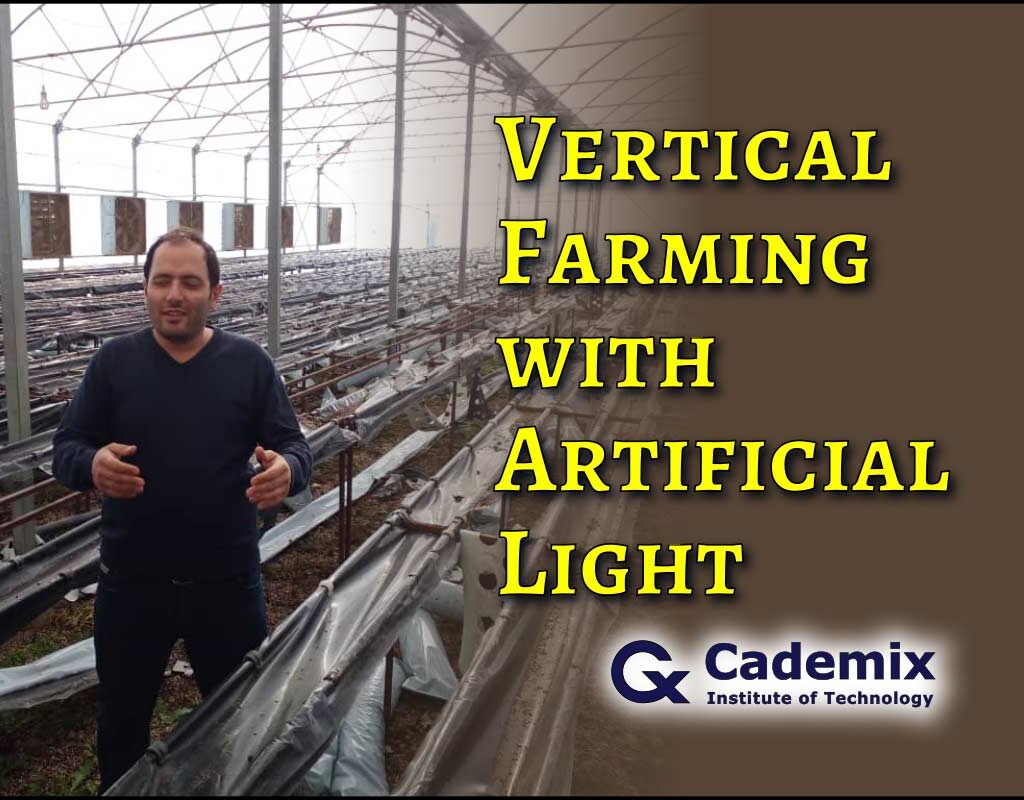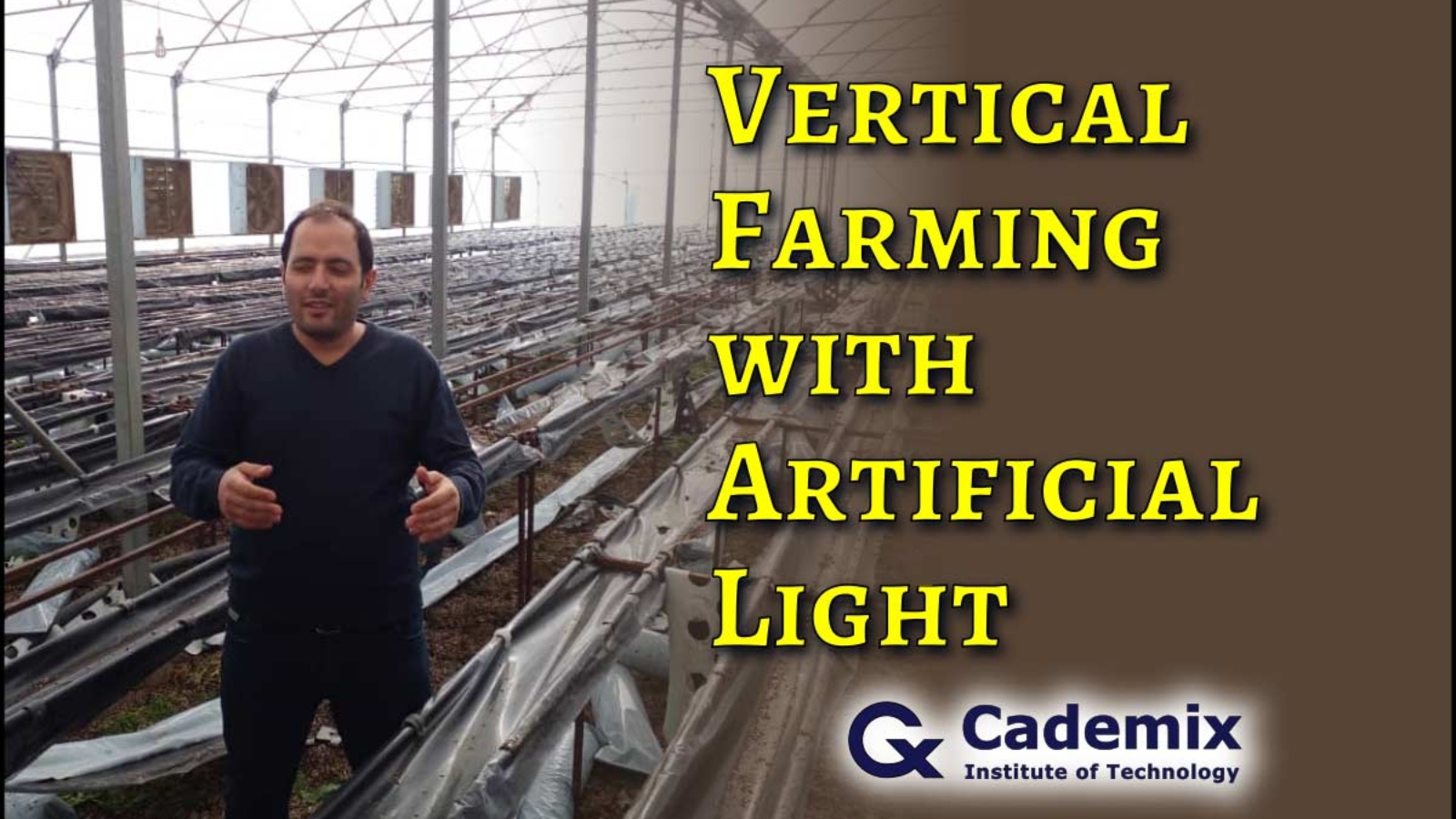Introduction
Vertical farming is revolutionizing agriculture by integrating cutting-edge technology to optimize food production in limited spaces. This approach leverages artificial light to simulate ideal growing conditions, paving the way for sustainable solutions in urban and resource-scarce environments. The technology not only addresses the challenges of traditional agriculture, such as land and water scarcity but also significantly reduces the carbon footprint.
This article provides a comprehensive review of vertical farming, focusing on its advancements, applications, and the role of artificial light in maximizing yield. By exploring challenges, opportunities, and future trends, this review aims to serve as a guide for researchers, policymakers, and agribusinesses seeking innovative agricultural methods.
Keywords: Vertical farming, artificial light, sustainable agriculture, urban farming, advanced agricultural technologies, energy-efficient farming, hydroponics, aeroponics, LED lighting in farming, future of agriculture
Feature
Almost one in every seven individuals on the planet is chronically hungry, lacking sufficient nourishment to be healthy and active. According to the United Nations, 795 million people throughout the world do not have enough to eat, and the world’s population is expected to reach 10 billion by 2050, with two-thirds of the population living in cities. As the world’s population grows, so does the demand for food, which necessitates increased usage of arable land and water. Soil deterioration is also a big issue, as it reduces the soil’s potential to support production and environmental activities. In order to feed the globe in the future, new farming technologies are necessary. In order to feed more people while using less land, creative solutions are required.
Definitions and prerequisites
Traditional field farming, at the ground level, relies on soil as the primary growing medium. Growers must encounter a number of constraints when it comes to soil. Limitations which take high amount of resources to make little probable changes. Because vertical farms do not employ soil, they are not limited to a single place.
Another advantage of indoor vertical farms over traditional farming is that they do not require sunlight. Indoor vertical farms use have to to provide their own light source for year-round photosynthesis, whereas typical farms’ growing cycles regulate by seasonal variations in temperature and sunlight. Indeed, as the cost of lighting source has decreased, the number of vertical farming systems has increased around the world. In fact, nothing could develop without the lights.
Visible light for plants
Electromagnetic waves transfer energy via the air. Electromagnetic waves include microwaves, radio or television waves, X-rays, ultraviolet rays, and visible light, all of which have varied frequencies and wavelengths. The electromagnetic spectrum depicts many frequencies and wavelengths that refer to by various names (microwave, radio waves, visible light, etc.). The human eye captures visible light with wavelengths between 400 to 700 nanometers (nm), which roughly correlates to the photosynthesis region of the spectrum. PAR, or photosynthetic active radiation, also define as light with a wavelength of 400 to 700 nm. Within and beyond the visible wavelengths, sunlight has a continuous spectrum. In the human brain, different wavelengths convert into colors by the human eye. Short wavelengths about 400 nm regard as blue, while longer wavelengths around 600 nm have perceived as red. The yellow-green wavelength area is the most sensitive to the human eye.
Light in plants
Plants absorb light in a spectrum that is approximately identical to the human eye, but unlike humans, they absorb red and blue light the best. Through photosynthesis, chlorophyll as one of the key chemicals that allows plants to absorb light and use its energy to convert water and carbon dioxide into oxygen and complex organic compounds. There is a green plant pigment found in the chloroplasts. It is responsible for the green coloration of leaves and stems. Chlorophyll a and b, differ in their light absorption curves, are the two main forms of chlorophyll found in higher plants. Because of the minor difference, they can collect different wavelengths, allowing them to capture more of the solar spectrum. Plants seem green because chlorophyll absorbs mostly red and blue light and reflects green wavelengths.
Artificial light in Vertical Farming
Due to artificial light is the only source of light in vertical farms, light intensity and spectrum are more important than in a greenhouse. It is also very important topic in the other fields such as modern architecture. Certain crops demand a high level of light intensity, which generates a significant amount of heat. We should later cool down the environment using various methods. The lower the cooling costs and the better the environmental management are, the less heat generated by the light source. Despite their compact size, fluorescents are not the best choice for vertical farming. The main reason is that they require expensive cooling facilities such as heat sink.
Unlike fluorescent lighting, LED lighting allows for less heat dissipation since the LEDs’ effectiveness value is higher than fluorescent lighting, indicating that a greater amount of the energy input transfer into light rather than heat. However, because LEDs emit heat, it is best to use an LED lighting type with a light spectrum that we adjust so we can employ lower light intensities. When there is less light to install overall, it saves money on hardware, installation, electricity, and cooling.
Light dispersion
In vertical farms, between addition to the optimum light intensity and spectrum, it is critical that the light dispersion, or uniformity, in the shelves is as good as possible to provide a consistent production rate across and among shelves.
Only red and blue LED chips used in the earliest LEDs for the horticultural sector; these spectra are still available and can use at a modest cost. Because they lack all other wavelengths in the spectrum, red and blue light boost photosynthesis but do not encourage biomass formation. High amount of yield is critical in a vertical farm as possible, so the best spectrum for the planted plant species should carefully select.
The Role of Artificial Light in Vertical Farming
Artificial light serves as the cornerstone of vertical farming by enabling consistent crop growth independent of natural sunlight. This innovation ensures that plants can grow in fully controlled environments, allowing for greater precision, productivity, and sustainability. The strategic use of artificial light optimizes photosynthesis and fosters year-round farming, making it a critical element in urban agricultural systems.
Understanding Light Spectrums and Plant Growth
Plants respond to specific wavelengths of light during their growth cycles. Artificial lighting systems, particularly LEDs, can be customized to emit targeted light spectrums that cater to different stages of plant development:
- Blue Light (400–500 nm): Promotes vegetative growth and leaf expansion.
- Red Light (600–700 nm): Stimulates flowering and fruiting processes.
- Far-Red Light (>700 nm): Influences stem elongation and flowering timing.
Advanced LED systems allow precise manipulation of these spectrums, enabling growers to fine-tune light delivery based on plant species and growth requirements. This tailored approach boosts crop yields and enhances nutritional value.
Energy Efficiency and Cost Savings
Traditional lighting systems like high-pressure sodium (HPS) lamps have high energy demands and heat output, which limit their efficiency. LEDs, however, revolutionize vertical farming with their low power consumption, minimal heat emission, and long lifespan. Key advantages of LED lighting include:
- Reduced Operational Costs: LEDs consume 40–70% less energy than traditional systems, significantly lowering electricity bills.
- Improved Durability: With lifespans of up to 50,000 hours, LEDs reduce maintenance costs and downtime.
- Localized Heat Reduction: Unlike older lighting systems, LEDs minimize heat stress on plants, improving growth conditions in tightly packed environments.
By integrating LED technology, vertical farms achieve higher profitability while reducing their carbon footprint.
Technological Innovations in Lighting Systems
Modern lighting systems have evolved beyond static LED fixtures. Some key innovations include:
Tunable LEDs: These systems adjust light spectrums dynamically to match a plant’s lifecycle. For instance, more blue light can be used during seedling stages, while red light dominates during flowering.
Multi-Directional Light Delivery: Fiber optics and reflective panels ensure uniform light distribution across multi-tiered structures.
Smart Light Controls: IoT-enabled systems monitor light intensity and duration, allowing growers to optimize energy use and plant health.
These advancements enable farmers to achieve precise control over lighting conditions, further enhancing productivity and resource efficiency.
Artificial Light and Sustainability Goals
The reliance on artificial light might raise concerns about energy consumption, but vertical farming aligns with global sustainability goals in several ways:
- Renewable Energy Integration: Many vertical farms now incorporate solar panels or wind turbines to power their lighting systems.
- Reduced Food Miles: Urban farms supply fresh produce locally, cutting down transportation emissions.
- Water and Resource Efficiency: Combined with hydroponic and aeroponic systems, artificial lighting ensures that every resource is maximized.
By using renewable energy sources and efficient light systems, vertical farming minimizes its environmental impact, making it a viable solution for sustainable food production.
Future Trends in Artificial Lighting
The future of artificial lighting in vertical farming is driven by research and innovation. Upcoming trends include:
- Quantum Dot LEDs: These promise even greater energy efficiency and customizable light spectrums.
- Integration with AI: Predictive analytics and machine learning will enable fully automated light adjustments tailored to real-time plant conditions.
- Ultraviolet (UV) Integration: Controlled UV light may enhance plant resistance to pests and diseases while boosting nutrient levels.
By adopting these technologies, vertical farming will continue to redefine modern agriculture, ensuring a balance between productivity and sustainability.
Explore cutting-edge LED technologies for agriculture
Learn more about spectrum-based farming approaches
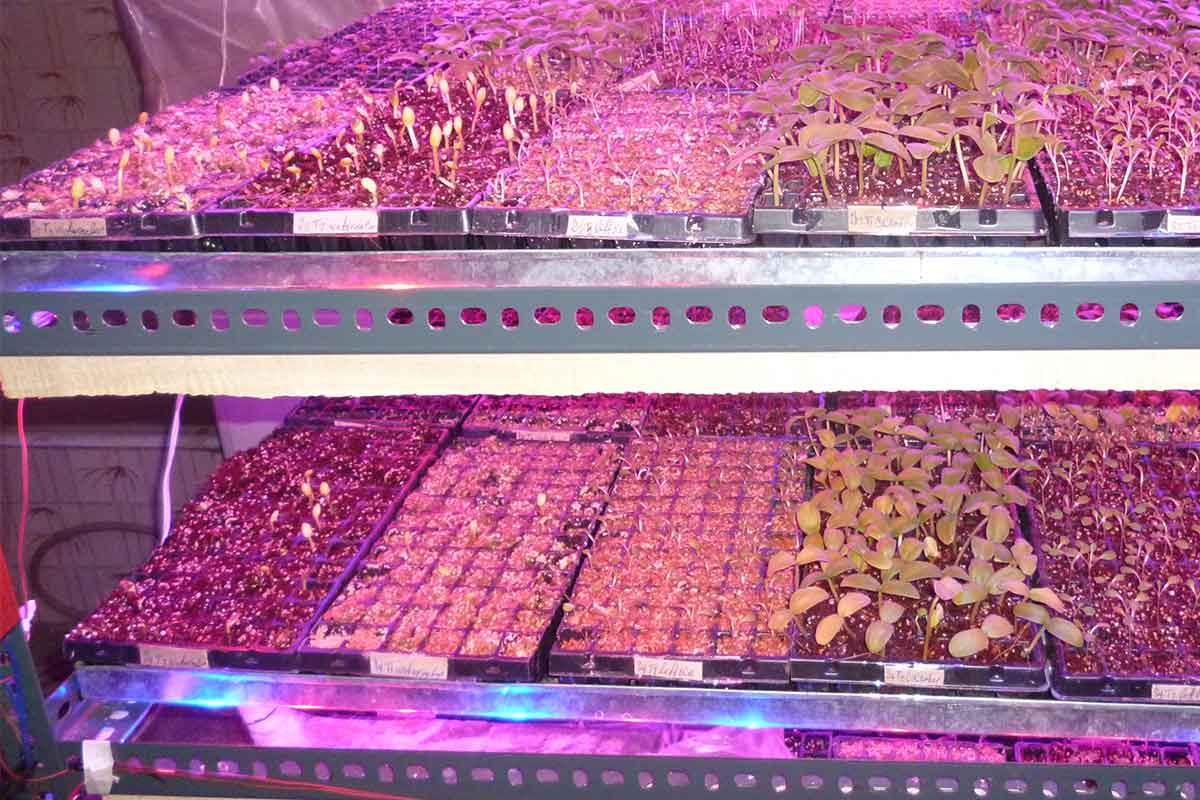
Technological Innovations in Vertical Farming
Technological advancements have revolutionized vertical farming, making it more efficient, sustainable, and scalable. The integration of cutting-edge tools such as IoT (Internet of Things), robotics, and machine learning has streamlined operations, allowing growers to precisely manage resources and improve yields. These technologies also facilitate a deeper understanding of plant biology and growth cycles, enhancing the industry’s ability to meet the demands of a growing population.
Key Innovations Driving Vertical Farming Success
1. Automated Climate Control
IoT-enabled sensors and systems continuously monitor and adjust key environmental parameters such as temperature, humidity, and CO₂ levels. These automated systems ensure plants receive optimal growing conditions while minimizing resource wastage. For instance, HVAC systems integrated with advanced climate controls enable energy-efficient operations, which are critical for reducing overhead costs.
2. Artificial Intelligence (AI) in Crop Management
AI-powered algorithms analyze vast amounts of data from sensors and cameras to optimize farming processes. These systems:
- Predict the best times for planting and harvesting.
- Detect early signs of diseases and pests, reducing crop loss.
- Recommend nutrient adjustments based on real-time plant health data.
An AI-powered vertical farm in Japan achieved a 30% increase in crop yield by predicting and mitigating risks such as water shortages and nutrient imbalances.
3. Hydroponic and Aeroponic Systems
These soilless farming methods optimize water and nutrient use, making vertical farming more sustainable. Hydroponics involves growing plants in nutrient-rich water, while aeroponics delivers nutrients through misting systems directly to plant roots. Both systems ensure resource efficiency, with hydroponics using up to 90% less water than traditional farming.
4. Robotics for Plant Maintenance
Robotic systems perform labor-intensive tasks such as seeding, pruning, and harvesting. Autonomous robots equipped with machine vision can navigate multi-layered farms to carry out precision tasks without human intervention. These innovations not only reduce labor costs but also ensure consistent quality.
5. Real-Time Data Analytics
Cloud-based platforms collect and analyze data on every aspect of the farming process, from growth rates to energy consumption. Farmers can access this data remotely, making it easier to make informed decisions and fine-tune operations.
Case Studies Highlighting Innovation
- Japan: The AI-integrated “Spread” farm produces over 30,000 heads of lettuce daily while using 50% less energy and 90% less water than conventional methods.
- The Netherlands: Known for its advanced agricultural technology, Dutch vertical farms utilize AI and robotics to achieve consistently high yields of diverse crops, from leafy greens to strawberries.
Emerging Trends in Vertical Farming
1. Vertical Integration of Renewable Energy
Combining solar panels or wind turbines with farming systems to offset energy demands is becoming a standard practice.
2. Advanced Automation with 5G Networks
Faster connectivity enables seamless integration of IoT devices, allowing for instantaneous responses to environmental changes.
3. Multi-Layered Farming with Modular Designs
Scalable, modular vertical farms allow growers to expand operations incrementally while maintaining efficiency.
4. Biometric Plant Monitoring
Advanced tools like chlorophyll meters and spectrophotometers assess plant health on a cellular level, ensuring nutrient delivery is optimized.
Conclusion: Transforming Agriculture Through Innovation
Technological innovations continue to push the boundaries of what is possible in vertical farming. These advancements not only improve the economic viability of vertical farming but also position it as a sustainable solution to global food security challenges. By adopting smart systems, farms worldwide can achieve higher yields, reduce environmental impact, and feed growing urban populations more effectively.
For more insights into IoT applications in agriculture, visit Agriculture IoT Applications.
Discover breakthroughs in AI for farming at AI in Agriculture.
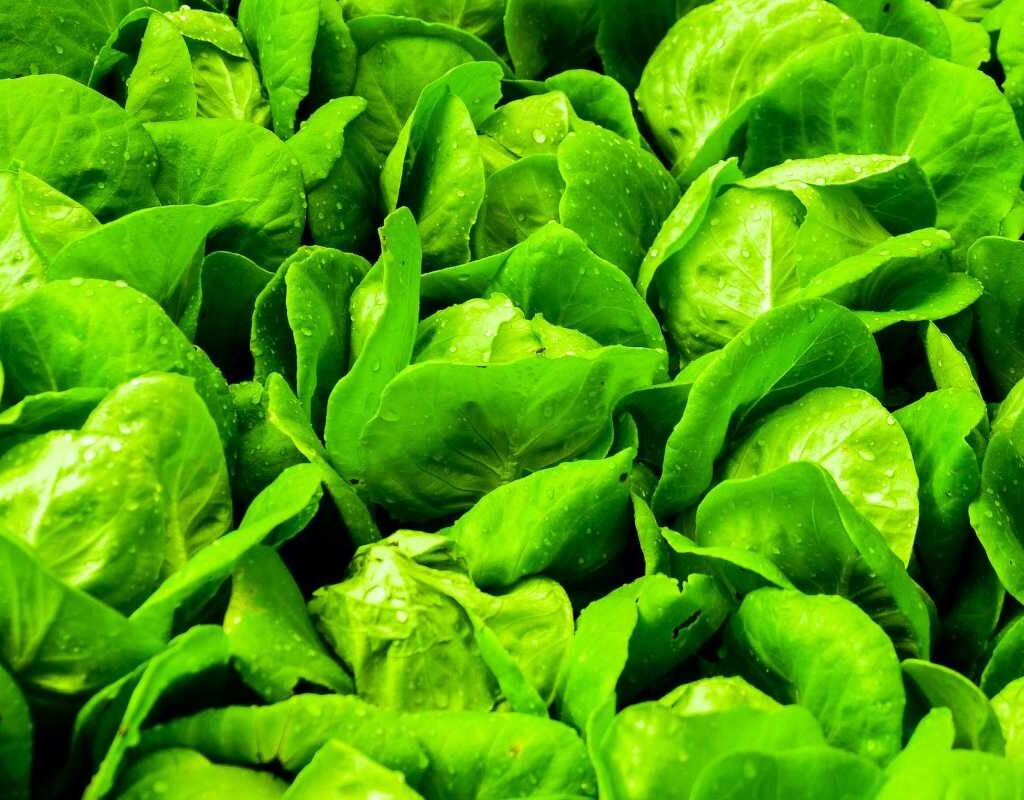
Nutrition in shelves
In the vertical farming, plants are planted through the shelves and fed up by hydroponic system. The term “hydroponics” is derived from the Greek words “water” and “work,”. Specifically, they refer to methods of cultivating plants without the use of soil. Although hydroponics may appear paradoxical to some, it offers a unique and sustainable approach to cultivate delicious and healthful foods.
Hydroponically grown plants have their roots dipped directly into nutrient-rich liquids. Plants produced in a hydroponic system have smaller root systems since they directly reach to the necessary nutrients. This matter leads to conserve energy and allows it to be redirected to leaf and enhance the growth more quickly. Plants grow more quicker in nutrient-rich solutions than they would in traditional ways. In addition, the hydroponics often delivers higher agricultural yields than traditional methods. Furthermore, because hydroponic systems do not rely on soil, they reduce pests and soil-borne diseases. Hence, they results in healthy crops that you can feel good about cultivating and eating.
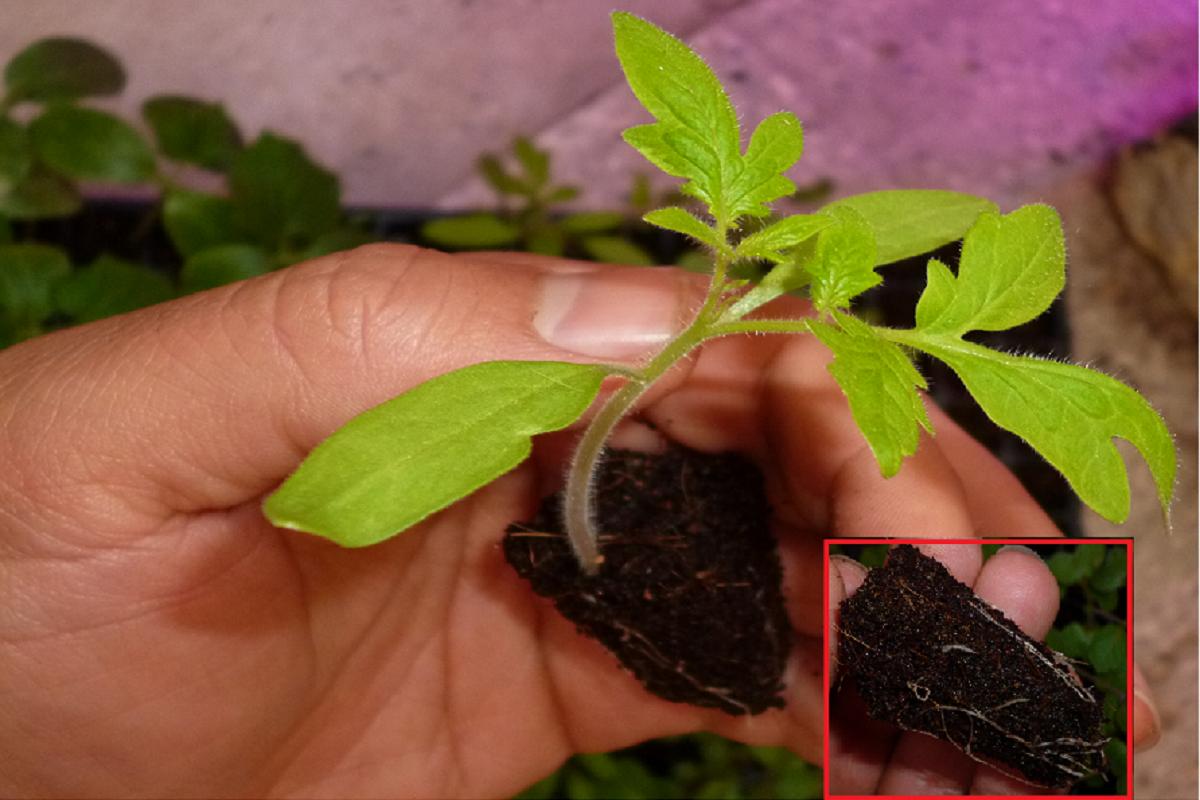
Tomato plantlet with developing rooting system produced through Vertical Farming
Economic and Environmental Impacts of Vertical Farming
Vertical farming is gaining significant attention due to its potential to address global food security challenges while mitigating environmental and economic issues associated with traditional agricultural practices. This innovative approach to farming utilizes artificial light and controlled environments to grow crops in stacked layers, often within urban areas. As the technology continues to evolve, its economic and environmental benefits are becoming increasingly clear. Below, we explore both the positive and negative impacts of vertical farming on the economy and the environment.
Economic Impacts
Job Creation and Economic Opportunities
One of the most significant economic benefits of vertical farming is the creation of new jobs in urban areas, particularly in regions where traditional farming is not feasible. From the installation of high-tech systems to daily farm management, vertical farming requires skilled workers in fields such as engineering, horticulture, and data science. This opens up new career paths and contributes to local economies by promoting high-tech agriculture.
In addition, vertical farms can help reduce the financial burden on food supply chains by eliminating the need for long-distance transportation. By growing crops close to urban centers, farmers can save on shipping and distribution costs, which often account for a significant portion of grocery prices. For example, in cities like New York and Tokyo, vertical farms are able to provide fresh produce directly to supermarkets and restaurants, ensuring products are delivered within hours of harvesting. This cuts down on food waste, which is a major economic issue in traditional farming systems, where spoilage during transportation can lead to significant losses.
Cost Efficiency and Resource Optimization
Vertical farms often employ hydroponic or aeroponic systems that use significantly less water compared to conventional agriculture. Hydroponic systems, which grow plants in nutrient-rich water rather than soil, can reduce water usage by up to 90% compared to traditional farming techniques. This is especially critical in areas facing water scarcity.
Energy consumption in vertical farming can also be optimized through the use of renewable energy sources, such as solar panels or wind turbines, helping reduce operational costs over time. However, it is important to note that the initial setup costs for vertical farms can be high due to the need for artificial lighting, climate control systems, and infrastructure. Despite these upfront expenses, vertical farming could eventually become more economically viable as technologies improve and economies of scale are realized.
Increased Crop Yields and High-Value Crops
Another key economic advantage of vertical farming is the potential for higher crop yields in smaller spaces. Because vertical farms operate indoors, they are not limited by the constraints of traditional outdoor farming. By utilizing multi-layered growing systems and optimized environmental conditions, vertical farms can produce several harvests per year in the same footprint. For example, crops such as lettuce, herbs, and microgreens can be harvested every few weeks, increasing production efficiency.
Furthermore, vertical farms provide the opportunity to grow high-value crops that are typically difficult or expensive to cultivate using traditional farming methods. Specialty crops like strawberries, herbs, and leafy greens are in high demand, and vertical farming’s controlled environments can provide ideal conditions for their growth.
Environmental Impacts
Water Conservation
Water scarcity is a growing global concern, particularly in regions that rely on traditional, soil-based agriculture, which requires massive amounts of water. In contrast, vertical farming systems often use closed-loop water systems, where water is continually recycled and reused. This not only conserves water but also reduces the environmental impact of farming in areas with limited water resources. For instance, vertical farms can reduce water usage by up to 90%, significantly alleviating pressure on local water supplies.
Additionally, the use of hydroponics or aeroponics allows plants to receive nutrients through water, reducing the amount of water needed for irrigation. The reduction of water wastage is particularly crucial in arid regions or areas suffering from droughts, where water scarcity is a significant concern.
Reduced Carbon Footprint
Vertical farming has the potential to dramatically reduce the carbon footprint of food production. Traditional agriculture requires large amounts of land, often leading to deforestation, soil degradation, and habitat loss. Vertical farms, on the other hand, use minimal land space while producing high yields. As these farms are typically located in urban areas, transportation distances for food are significantly shortened, leading to lower carbon emissions from the supply chain. Additionally, by using energy-efficient systems such as LED lights and solar power, vertical farms can minimize energy consumption, contributing to a reduction in overall greenhouse gas emissions.
Vertical farming also has the potential to reduce food waste. In traditional farming systems, crops are often wasted due to transportation delays, poor storage conditions, or damage during harvesting. Since vertical farms are located closer to consumers, food can be harvested, processed, and distributed within hours, significantly reducing the amount of food that goes to waste.
Urban Sustainability and Land Use
Vertical farming offers a solution to the challenges posed by urbanization. With increasing urban populations and limited agricultural land, vertical farming can repurpose underutilized buildings or vacant lots in cities to grow food. This reduces the pressure on rural landscapes and promotes urban sustainability. By growing food closer to where it will be consumed, vertical farming contributes to local food security, reduces transportation costs, and provides fresh produce year-round.
Moreover, vertical farming has the potential to improve biodiversity in urban areas. By using multi-layered growing systems and controlled environments, vertical farms can be designed to accommodate diverse plant species, including both crops and ornamental plants. These urban farms can act as green spaces, enhancing local ecosystems and contributing to overall urban biodiversity.
Energy Efficiency and Sustainability
While vertical farming has the potential to reduce energy consumption by utilizing renewable energy sources and energy-efficient technologies, it is important to consider the environmental impact of artificial lighting. Most vertical farms rely heavily on artificial light, particularly LED lighting, to provide crops with the necessary spectrum for photosynthesis. While LED lighting is more energy-efficient than traditional lighting, it still requires substantial energy inputs, particularly in regions where natural light is limited. However, with advancements in energy-efficient technologies and the integration of renewable energy sources, vertical farms may eventually achieve net-zero energy use.
Challenges and Considerations
Despite the numerous benefits, vertical farming faces several challenges that need to be addressed to maximize its economic and environmental potential. The high upfront costs for infrastructure, technology, and energy consumption can be prohibitive, especially for smaller-scale operations. Additionally, while vertical farming can reduce land and water usage, its reliance on artificial lighting and climate control systems raises questions about long-term energy consumption and sustainability.
Skilled Labor Shortages: Managing high-tech systems necessitates a specialized workforce. Vertical farming operations require skilled labor in fields such as agronomy, engineering, data science, and robotics. However, the availability of workers with the necessary expertise in these areas is currently limited, creating a gap in the labor market. To address this, education and training programs focused on the unique needs of vertical farming are essential. As the sector grows, developing a well-trained workforce will be crucial to ensuring the success and scalability of these operations.
As technology continues to advance and new innovations emerge, vertical farming holds significant promise for transforming agriculture into a more sustainable, efficient, and environmentally friendly practice. With the potential to address key issues such as food security, water scarcity, and carbon emissions, vertical farming represents a critical step toward a more sustainable and resilient global food system. Overcoming these barriers requires a combination of policy support, technological innovation, and public-private partnerships to make vertical farming more accessible and cost-effective.
For more insights into the economic benefits of vertical farming, visit AgFunder.
Explore the latest research on the environmental impacts of vertical farming at World Economic Forum
Future Trends in Artificial Lighting
The future of artificial lighting in vertical farming is driven by research and innovation. Upcoming trends include:
- Quantum Dot LEDs: These promise even greater energy efficiency and customizable light spectrums.
- Integration with AI: Predictive analytics and machine learning will enable fully automated light adjustments tailored to real-time plant conditions.
- Ultraviolet (UV) Integration: Controlled UV light may enhance plant resistance to pests and diseases while boosting nutrient levels.
By adopting these technologies, vertical farming will continue to redefine modern agriculture, ensuring a balance between productivity and sustainability.
Explore cutting-edge LED technologies for agriculture
Learn more about spectrum-based farming approaches Are Indoor Vertical
Are Indoor Vertical Farming Capable of Feeding the World?
While indoor vertical farming offers distinct advantages to the challenges of feeding an expanding world, the output of these farms alone would not be sufficient to feed the entire population. To build a more resilient and sustainable food system, traditional and indoor growers must continue to collaborate.
We’re only getting started; there’s still a lot of opportunity for development. Growers will discover how to obtain a lot more from their farming system. Breeders are developing unique kinds for this type of farming. Vertical farming can only be taken to the next level if crop experts, technicians, marketers, and investors work together. That is both required and feasible.
I hope you find this article (Vertical Farming with Artificial Light: Review and Future advancement) useful.
Here it is some of my articles you can find them:
- Growing in Sawdust: Alternative Planting Medium in Vertical farming.
- Healthy Food Production Challenges in Developing Countries.
- In vitro Regeneration of Alstroemeria cv. ‘Balance’ by Indirect Organogenesis.
- In vitro Regeneration of Alstroemeria cv. ‘Balance’ Based on Direct Organogenesis.
- Innovative Optimal Approach to Implement Fast Propagation Tissue Culture.
Feel free to contact me for questions, consulting or any projects.
Email: hossein_nazarian@yahoo.com
Email: hossein.nazarian@cademix.org
LinkedIn: https://www.linkedin.com/in/hossein-nazarian/
Xing: https://www.xing.com/profile/Hossein_Nazarian
About the Author
Hossein Nazarian is a graduate of MSc. in Agricultural Biotechnology Engineering from Iran and an associate member at the Cademix Institute of Technology and the Cademix Career Autopilot Program.
He has also obtained his bachelor diploma in Plant Production Engineering which has provided him with an understanding of different aspects of agriculture. For instance he was working on cultivation, irrigation, fertilization, plant protection and commercial services. He has been working in several areas in agricultural sector since 2009. He has valuable experiences as an instructor and technical expert in plant pests, diseases, nutrition, and plant protection programs. Also He he has some experiences in the greenhouse cultures and plantlets produce through artificial light in the shelves. He has been working in agribusinesses for 12 years and try to solve farmers’ problems. Further he helps to produce healthy products to improve the health level of society.
Specialties: Plant nutrition, Plant protection, Field management. Greenhouse consultant (rose, cucumber, strawberry, transplant,…), Tissue culture, Marketing, Agile management.
Keywords related to Vertical Farming
Hydroponic, Artificial light, Urban farming, Greenhouse culture, Vertical garden. Vertical green, Vertical gardening, Artificial light for plants are some of the keywords. Further keywords, Hydroponic system, Hydroponic garden, Hydroponic design, Hydroponic greenhouse, Arable land. Soil deterioration, globe in the future, Creative solutions, Indoor, Indoor plants, Indoor garden, Indoor greenhouse. In addition, Shelf greenhouse, Controlled environment. Controlled environment agriculture, Controlled environment technologies, Multilayer plant production, Lettuce, Aromatic plants. Culinary condiments, Microgreens. Further, Sprouts, Baby vegetables, Energy-efficient LED lights, Photosynthesis, Photosynthetic Active Radiation, Electromagnetic waves, optic, grow lights, Visible light. Finally other keywords are Plant pigments, Photoreceptors, Photosynthesis, Spectrum, Chlorophyll, Phytochromes, Fluorescents.
